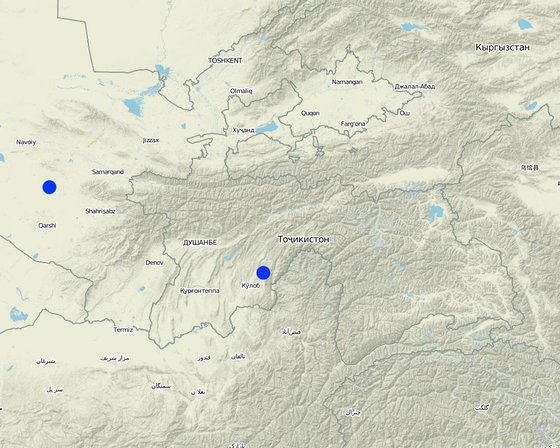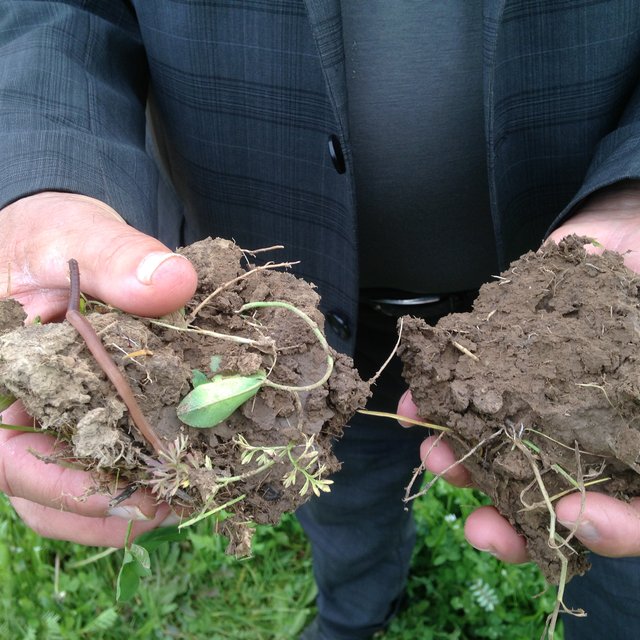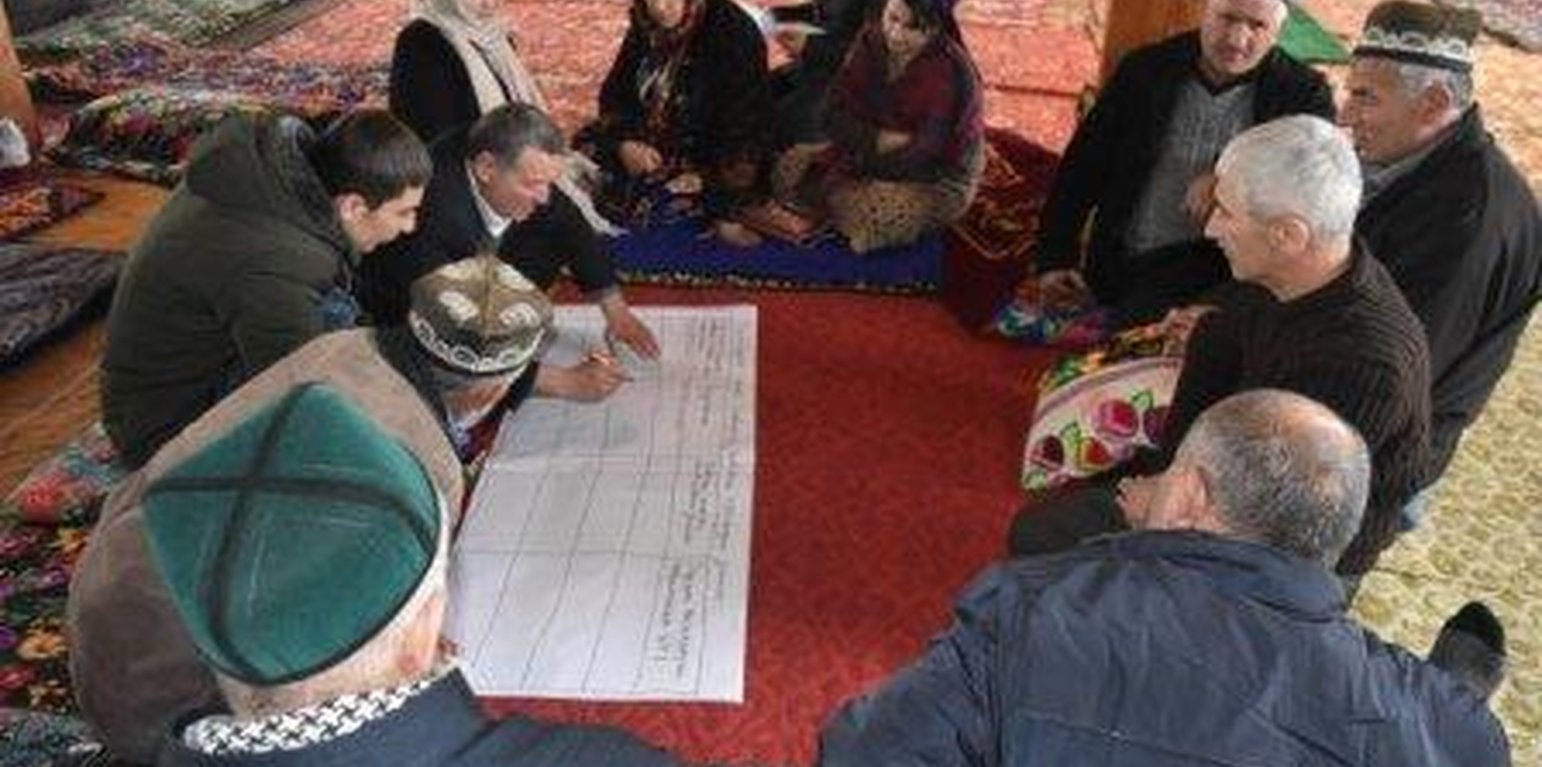Participatory Land use planning and assessment
(ทาจิกิสถาน)
Накшаи муштараки истифодабари ва бахогузории замин
คำอธิบาย
Participatory Land Use Planning and Assessment is an inter disciplinary approach to the land use with combination of the modern tools and community knowledge to identify land degradations with its intensity and trends and through this approach design intervention directed toward land degradation prevention. This approach also compiles different tools including PRA and soil assessment and LADA techniques in a participatory manner. The approach address issues with all categories of land use including crop and pasture land, forest and even settlement with regards to natural disaster consideration for construction.
As a precondition to the development of evidence- and needs-based plans, Participatory Land Use Planning and Assessment (PLUPA) will be conducted, with participation of local specialists, to assess sub-watershed natural and human-induced hazards and natural resource conditions, and IHA results will be presented to community and local government stakeholders to foster ownership. The outcome will improve community involvement in development by enhancing the ability to conduct local development planning and implementation.
Attention will be given to promoting the role of women in local development.
The PLUPA will employ terrestrial inspection of the land using simplified tools based on the WOCAT questionnaire for the land management technologies. The field-based assessment will include physical inspection of the land use and collecting necessary data like GPS points and information on target watershed (e.g. availability of pastureland, natural hazards, public and private infrastructure). The remote sensing component will be used for analyzing images and identification of trend analysis as well erosion on soil, land degradation.
Communities (via CSOs) and local governments are involved in conducting PLUPA, and will drive and own the result for development of their plan at watershed level. They will also be core stakeholders in the prioritization of water, health, and NRM interventions as per watershed management plan, and will be partners and contributors (including financially) in construction and management of new infrastructure post-project. This fosters commitment and ownership, promoting development that is accountable, participatory, inclusive, transparent, and efficient.
สถานที่

สถานที่: ทาจิกิสถาน
ตำแหน่งทางภูมิศาสตร์ของสถานที่ที่ถูกเลือ
-
65.83089, 39.42232
-
70.02718, 38.1114
-
70.02208, 38.10678
วันที่ริเริ่ม: n.a.
ปีที่สิ้นสุด: n.a.
ประเภทของแนวทาง
-
แบบดั้งเดิม/ แบบพื้นเมิอง
-
เป็นนวัตกรรมท้องถิ่นล่าสุด/ นวัตกรรมใหม่
-
ใช้โครงงานหรือแผนงานเป็นฐาน

Participatory soil assessment at community level with combining of traditional and scientific knowledge. (Amirali Kassam)
แนวทางการดำเนินการและบรรยากาศการพัฒนาที่เอื้ออํานวย
เป้าหมายหรือวัตถุประสงค์หลักของแนวทาง
The main goal of the approach is to bring together stakeholders to use simplified methods on soil assessment and raise awareness on the importance of soil health for production. Based on that approach communities will design action for better management of their land and soil conservaiton
เงื่อนไขที่เอื้ออำนวยต่อการนำเอาเทคโนโลยีภายใต้แนวทางนี้ไปปฏิบัติใช้
-
กรอบแนวทางในการดำเนินการด้านกฎหมาย (การถือครองที่ดิน สิทธิในการใช้ที่ดินและน้ำ): farmers are organized in a legal structure, which is make them compliant to the land rights and supported with planning for land use
-
ตลาด (จัดซื้อปัจจัยนำเข้า ขายผลิตภัณฑ์) และราคา: there is a lot of demand for food products in the markets and existing service providers who supply inputs. If land use planning is organized in a good way community will get good benefit from farming.
เงื่อนไขที่เป็นอุปสรรคต่อการนำเอาเทคโนโลยีภายใต้แนวทางนี้ไปปฏิบัติใช้
-
บรรทัดฐานและค่านิยมทางสังคม วัฒนธรรม ศาสนา: people are not organized well and land use planning is taking place on a add-hoc basis. traditional knowledge, which is bind to local culture and social norms is lost with applying pre-modern agriculture practice for what community does not have proper access to resources, such as inputs and tehcnology
-
ความรู้เกี่ยวกับ SLM การเข้าถึงการสนับสนุนด้านเทคนิค: not all farmers, which got land have farming knowledge and practices on SLM. Basic practices which they learn from other farmer or inherited from their generation.
การมีส่วนร่วมและบทบาทของผู้มีส่วนได้เสีย
ผู้มีส่วนได้เสียที่เกี่ยวข้องในแนวทางนี้และบทบาท
| ผู้มีส่วนได้เสียหรือองค์กรที่นำไปปฏิบัติใช้มีส่วนเกี่ยวข้องกับแนวทางนี้อย่างไร |
ระบุผู้มีส่วนได้ส่วนเสีย |
อธิบายบทบาทของผู้มีส่วนได้ส่วนเสีย |
| ผู้ใช้ที่ดินระดับท้องถิ่นหรือชุมชนระดับท้องถิ่น |
land users, forest user, pasture users, |
plan and provide field based knowledge on land use practices |
| องค์กรที่ขึ้นอยู่กับชุมชน |
village organization and different initiative groups with regards to land use |
support with mobilizing communities for better planning of the land resource and motivate collaboration between different land users |
| ผู้เชี่ยวชาญ SLM หรือที่ปรึกษาการเกษตร |
land management, forest, pasture specialist from related department of government |
support with providing technical knowledge and solving the current land use issues with applying/providing good practices |
| รัฐบาลระดับท้องถิ่น |
sub-district and district level |
facilitate the process of collaboration among different land users and make decision on future perspective of land use |
การเกี่ยวข้องของผู้ใช้ที่ดินระดับท้องถิ่นหรือชุมชนระดับท้องถิ่นในช่วงต่าง ๆ ของแนวทาง
ไม่มี
ไม่ลงมือ
จ่ายเงินหรือสนับสนุนจากภายนอก
ปฏิสัมพันธ์
ระดมกำลังด้วยตนเอง
การริเริ่มหรือการจูงใจ
land users of different categories, including pasture users, forest user etc,. come together to discuss the future land use perspective and decide on organizing themselves in better management of their land resources
การวางแผน
all stakeholders involved and support different perspective of land use categories and jointly plan for the future land use
การดำเนินการ
all stakeholders, involved in different land use categories negotiate and agree on terms and condition with regards complement the different land use importance.
การติดตามตรวจสอบหรือการประเมินผล
all stakeholders are passive in following the progress and results from land use intervention.
การตัดสินใจในการเลือกใช้เทคโนโลยี SLM
การตัดสินใจถูกทำโดย
-
ผู้ใช้ที่ดินเพียงผู้เดียว ( ริเริ่มด้วยตัวเอง)
-
ผู้ใช้ที่ดินเป็นผู้ตัดสินใจหลัก โดยการสนับสนุนจากผู้เชี่ยวชาญ SLM
-
ผู้ลงมือปฏิบัติที่เกี่ยวข้องทั้งหมดในฐานะที่เป็นส่วนรวมของแนวทาง
-
ผู้เชี่ยวชาญ SLM เป็นผู้ตัดสินใจหลัก ที่ติดตามให้คำปรึกษากับผู้ใช้ที่ดิน
-
ผู้เชี่ยวชาญ SLM เพียงผู้เดียว
-
นักการเมืองหรือผู้นำ
การตัดสินใจถูกตัดสินอยู่บนพื้นฐานของ
-
การประเมินความรู้ SLM ที่ได้ทำการบันทึกไว้เป็นอย่างดี (การใช้ข้อมูลในการตัดสินใจ)
-
สิ่งที่ค้นพบจากงานวิจัย
-
ประสบการณ์และความคิดเห็นส่วนตัว (ไม่ได้ลงบันทึกไว้)
การสนับสนุนด้านเทคนิค การสร้างขีดความสามารถ และการจัดการด้านความรู้
กิจกรรมหรือการบริการต่อจากนี้เป็นส่วนหนึ่งของแนวทาง
-
การสร้างขีดความสามารถ / การอบรม
-
การบริการให้คำแนะนำ
-
การเสริมความแข็งแกร่งให้กับสถาบัน (การพัฒนาองค์กร)
-
การติดตามตรวจสอบและประเมินผล
-
การวิจัย
การสร้างสมรรถภาพหรือการอบรม
การจัดอบรมถูกจัดขึ้นสำหรับผู้มีส่วนได้ส่วนเสียต่อไปนี้
-
ผู้ใช้ที่ดิน
-
เจ้าหน้าที่ภาคสนาม / ที่ปรึกษา
รูปแบบของการอบรม
-
กำลังดำเนินการ
-
เกษตรกรกับเกษตรกร
-
ใช้พื้นที่ทำการสาธิต
-
จัดการประชุมสู่สาธารณชน
-
จัดคอร์ส
หัวข้อที่อบรม
land degradation, soil assessment, land management
การสร้างความแข็งแกร่งให้กับองค์กร
องค์กรถูกทำให้แข็งแกร่งขึ้นหรือจัดตั้งขึ้น
-
ไม่
-
ใช่ เล็กน้อย
-
ใช่ ปานกลาง
-
ใช่ อย่างมาก
อธิบายถึงสถาบัน บทบาทและความรับผิดชอบ สมาชิก เป็นต้น
land use committee under the village organization as small entity dealing with land issues in the community only
ประเภทของการให้ความช่วยเหลือสนับสนุน
-
ด้านการเงิน
-
การสร้างขีดความสามารถ / การอบรม
-
อุปกรณ์
รายละเอียดเพิ่มเติม
land management, land degradation prevention
การสนับสนุนด้านการเงินและวัสดุอุปกรณ์
งบประมาณประจำปีสำหรับองค์ประกอบ SLM เป็นจำนวนดอลลาร์สหรัฐ
-
< 2,000
-
2,000-10,000
-
10,000-100,000
-
10,000-100,000
-
> 1,000,000
Precise annual budget: n.a.
การบริการหรือแรงจูงใจต่อจากนี้ได้ถูกจัดให้สำหรับผู้ใช้ที่ดิน
-
การสนับสนุนด้านการเงิน / วัสดุอุปกรณ์ให้แก่ผู้ใช้ที่ดิน
-
เงินสนับสนุนสำหรับปัจจัยการผลิต
-
เครดิต
-
แรงจูงใจหรือเครื่องมืออื่น ๆ
เเรงจูงใจหรือเครื่องมืออื่นๆ
some funding was made available for implementation of action prioritized in the land use planning
ผลกระทบและสรุปคำบอกกล่าว
ผลกระทบของแนวทาง
ไม่ใช่
ใช่ เล็กน้อย
ใช่ ปานกลาง
ใช่ อย่างมาก
ทำให้ผู้ใช้ที่ดินระดับท้องถิ่นมีอำนาจขึ้น ปรับปรุงการเข้าร่วมของผู้มีส่วนได้ส่วนเสียให้ดีขึ้นหรือไม่
the process follow by series of capacity building trainings, which are empowering community to get knowledge and understanding
ช่วยในการตัดสินใจโดยดูจากหลักฐาน ได้หรือไม่
as the approach involve participatory methods decision is made equally by all stockholders, including land users
ช่วยให้ผู้ใช้ที่ดินนำเอาเทคโนโลยี SLMไปใช้และบำรุงรักษาสภาพไว้ได้หรือไม่
as a result of the approach action plan with implementing of technologies is involved
ระดมกำลังหรือปรับปรุงการเข้าถึงแหล่ง เงินทุนสำหรับการดำเนินการ SLM หรือไม่
the approach results in a sophisticated document as plan and assessment report, which will then attracts funding for easy reference
ช่วยบรรเทาความขัดแย้งหรือไม่
the plan is mobilize communities and other stakeholder to collaborate and work together and negotiate and resolve emerging conflicts over resource
แรงจูงใจหลักของผู้ใช้ที่ดินเพื่อที่จะนำ SLM ไปปฏิบัติใช้
-
การผลิตที่เพิ่มขึ้น
-
กำไร (ความสามารถ) อัตราส่วนค่าใช้จ่ายต่อผลประโยชน์ที่เพิ่มขึ้น
-
การเสื่อมของที่ดินลดลง
-
ความเสี่ยงของภัยพิบัติลดลง
-
ภาระงานลดลง
-
การจ่ายเงินหรือการช่วยเหลือ
-
กฎและระเบียบ (ค่าปรับ) หรือการบังคับใช้
-
เกียรติภูมิ แรงกดดันทางสังคม ความเชื่อมแน่นทางสังคม
-
การเข้าร่วมสมทบในขบวนการ โครงการ กลุ่ม เครือข่าย
-
จิตสำนึกด้านสิ่งแวดล้อม
-
ประเพณีและความเชื่อ ศีลธรรม
-
ความรู้และทักษะ SLM ที่เพิ่มพูนขึ้น
-
การปรับปรุงด้านสุทรียภาพ
-
การบรรเทาด้านความขัดแย้ง
ความยั่งยืนของกิจกรรมของแนวทาง
ผู้ใช้ปที่ดินสามารถทำให้สิ่งต่างๆ ที่ได้ปฏิบัติใช้โดยแนวทางนี้ยั่งยืนได้หรือไม่ (โดยไม่มีการสนับสนุนจากภายนอก)?
บทสรุปหรือบทเรียนที่ได้รับ
จุดแข็ง: มุมมองของผู้ใช้ที่ดิน
-
participatory
-
simply approach applied by community members themselve
จุดแข็ง: ทัศนคติของผู้รวบรวมหรือวิทยากรคนอื่นๆ
-
provides visions, empowers land users to negotiate interventions among them, also raise awareness on the sustainability aspects of land use and provides more aspects on land conservation techniques for land term land use
จุดด้อย/ข้อเสีย/ความเสี่ยง: มุมมองของผู้ใช้ที่ดินแก้ไขปัญหาได้อย่างไร
-
time consuming, required a lot of facilitation
more awareness on communities knowledge about long term land use benefits. strengthen local legal framework to sustain and promote the planing process
จุดด้อย/ข้อเสีย/ความเสี่ยง: ทัศนคติของผู้รวบรวมหรือวิทยากรคนอื่นๆแก้ไขปัญหาได้อย่างไร
-
SLM knowledge and capacity
trainings for the local institutes involved in land use planing and management
การอ้างอิง
วันที่จัดทำเอกสาร: 13 เมษายน 2018
การอัพเดทล่าสุด: 12 มิถุนายน 2018
วิทยากร
-
Askarsho Zevarshoev (askarsho2006@yahoo.com) - ผู้เชี่ยวชาญ SLM
คำอธิบายฉบับเต็มในฐานข้อมูล WOCAT
การจัดทำเอกสารถูกทำโดย
องค์กร
- Aga Khan Foundation (AKF) - สวิตเซอร์แลนด์
โครงการ
- Integrated Health and Habitat Improvement in Rasht Valley, Tajikistan
การอ้งอิงหลัก
-
Participatory Land Use Planning, 2011: Free of charge, from SLM compiler





